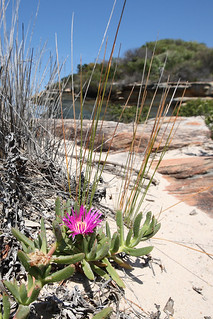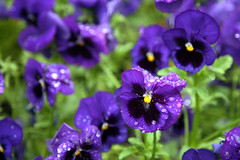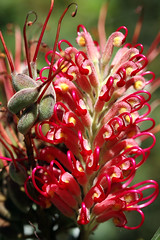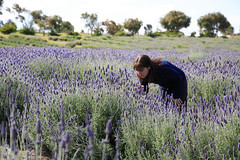

| Archive Blog Cast Forum RSS Books! Poll Results About Search Fan Art Podcast More Stuff Random |
|
Classic comic reruns every day
|
1 {photo of the a bee collecting nectar and pollen from a flower}
1 Caption: Flower Market
|
First (1) | Previous (3253) | Next (3255) || Latest Rerun (2891) |
Latest New (5380) First 5 | Previous 5 | Next 5 | Latest 5 Annotations theme: First | Previous | Next | Latest || First 5 | Previous 5 | Next 5 | Latest 5 This strip's permanent URL: http://www.irregularwebcomic.net/3254.html
Annotations off: turn on
Annotations on: turn off
|
 Greens and browns. Except for one small thing. |
Unless it's the right season for flowers. Flowers break all the rules for colour in nature. They stick out. And there's a good reason for that. Flowers are sex organs.
Sex, or more precisely sexual reproduction, is the process by which organisms of the same species exchange pieces of genetic material, allowing their genetic material to mix to produce offspring that have some of the traits of each parent. This is a good way to reproduce, because it provides variation in the genetic make-up of different individuals of the species.
Many plants can also reproduce (or be reproduced) by a different process, called vegetative reproduction. Basically, if you cut a plant in two, each part may live and grow to become a new plant. This can happen naturally, if a plant sends out runners or shoots that start growing and then become separated. Or it can be done by humans (or occasionally other animals) if we divide a plant by various means. This doesn't always work; some types of plants take to it better than others. Cut off a leaf of an African violet and stick it in some soil, and you'll grow a new African violet. Cut off a leaf of a lemon tree and stick it in soil, and it will just rot.
Although this ability to reproduce by division is handy, the child plants have the same genetic make-up as the parent. This means they're just as vulnerable to specific diseases or pests or predators or adverse climatic conditions as the parents. This is where sex helps. By mixing up the sets of genes of two different parents, the child inherits some of the characteristics of each parent. Also, genetic mixing and the expression of genes in a grown individual are complex processes that can give rise to traits in the child that neither parent possessed.[1] All of this leads to a wide variation in the traits and abilities of the children. Some of those traits could, by chance, lead to an improved chance of surviving a disease or avoiding being eaten. (Similarly, some of the traits may lead to a worse chance of surviving disease or predation. The process is random after all.)
 Trait inherited from parents, or mutation? |
None of this is conscious or directed in any sense, other than that it is the natural consequence of how genetics and reproduction work. At this point I should point out that organisms that reproduce asexually, by bodily division, do also accumulate some genetic diversity and thus variation in traits of offspring as well. The genetic copying mechanism is not perfect and occasionally results in random changes, called mutations. So asexual organisms can adapt and evolve over generations too, it's just that sexual organisms are faster and better at it.
So, back to flowers, which are a plant's way of engaging in sex. Not all plants have flowers, though. Ferns and conifers reproduce sexually without flowers. But flowering plants are more common and more widespread, as well as more familiar to many of us.
The eggs of a flowering plant are called ovules and they sit deep inside the flower, in a structure called the ovary. Typically, surrounding this are stalks with pollen on the ends. Pollen is a granular, powdery material which is the plant equivalent of sperm, the male reproductive cells. Most plants produce both ovules and pollen, often in the same flowers, making them both male and female at the same time.
 A diecious plant. Ginkgo biloba tree. |
But if you have both male and female parts, like most flowering plants, you don't want to end up fertilising yourself all the time. It's much better to cross-pollinate with other members of your species, to get the benefits of sexual reproduction outlined above. This is why flowers with both sexes usually have mechanisms that act to prevent self-pollination. A simple example is flowers in which the pollen matures first and gets distributed out to other plants, while the ovules don't mature and become receptive to pollen until some time later. Many, many flowers work this way. Others have convoluted shapes that assure that most, if not all, the pollen is distributed away from the flower's own ovary.
And here's where pollen distribution comes in. There are two basic methods that plants use to fertilise one another. Since they can't move around like animals to seek a mate, they need some other method of sending pollen to each other. The first method is to make use of the wind. Some flowers simply produce vast quantities of dust-light pollen and expose it to the open air, so that the lightest breeze carries it away. Cast enough out, and the air becomes so thick with microscopic pollen grains that pretty much everything within tens, hundreds, even thousands of metres is covered with them. This includes receptive flowers of the same species, and so pollination occurs and the ovules can develop into seeds.
 Grass flowers and seed heads. |
The flowers of grasses are tiny. So small that most people never even notice them. But they don't need to be noticed, since the wind does all the work of distributing their pollen. The pollen lands randomly on other grass flowers, and its job is done.
But wind is only one way of distributing pollen. The other method is more targeted. It involves recruiting animals to carry the pollen from one plant to another. Animals in general seek two things: food and sex. One way in which plants coerce animals to carry pollen is to provide food. And since flowers are where the pollen is, that's where the food is produced. Many flowers produce a sweet, sugary liquid called nectar. Many animals seek out nectar as a food source. So far, so good for the animal. But the flowers of a nectar-producing plant are shaped so that gathering the nectar involves poking your head or tongue deep inside the flower. As an animal such as a bird or butterfly does this, it brushes against the stamens of the flower, and the pollen on them sticks to the animal. It goes off to find another flower to suck nectar from, moving from plant to plant as it does so. And so it carries the pollen to different plants, where it brushes off and enters the ovary of the receiving flower, to fertilise the ovules inside.
 Pansies, showing typical colouration used to attract insects. |
Flower shapes also vary according to what sorts of animals pollinate them. Some are specialised for insects, others for birds, and some for more exotic species like monkeys or lizards. The two major groups of pollinators are insects and birds, and they have very different requirements. Insects have vision that tends towards the violet end of the visible spectrum of light, and even a little into the ultraviolet. Correspondingly, flowers that attract insects are frequently bright in blues and purples (which also includes white flowers). They also often have bold patterns, like the sharp dark and light coloured contrasts seen on pansies. In some cases, insect-pollinated flowers appear drab to our eyes, but viewed in ultraviolet light they show striking patterns which catch ultraviolet-sensitive insect eyes. Another thing about insects is that they have an excellent sense of smell - far better than humans. And so another way for flowers to attract insect pollinators is to produce an aroma. For the luscious smell of roses or lavender or orange blossoms (or jasmine, which personally I hate the smell of), we can thank insects.
 Grevillea. Large scentless red flowers - bird pollinated. |
Flowers are essentially a marketplace, advertising their wares to attract the right customers who are interested in them. If you go outside and take look and sniff at some flowers, you'll pretty reliably be able to tell what pollinates them. Large, red flower with no smell: birds. Small white or purple flower, or any flower with a smell: insects.
I've mentioned one way in which flowers can attract pollinators, by offering them food. Some flowers use the second option that animals seek: sex. Or at least the promise of sex. Some flowers offer no food, but instead are shaped in a way that resembles a female insect. Backing this up, such flowers often produce a scent that closely matches the scent produced by the female insect to attract a mate. The combination of these two factors attracts males of the mimicked species, and they attempt to mate with the flower, climbing over it and getting into what seems to be the right position. It turns out this is the right position for the flower to attach pollen to the frustrated male insect, who then goes away in search of another mate, and is likely to find a similar flower which will be ready to accept the pollen he is carrying. The floral masters of this game of sexual coercion are the orchids, many of which mimic the shapes and scents of various species of bees, flies, and moths.
And so we return to sex, which is the whole reason for the existence of flowers in the first place. Just think about that next time you consider buying your date or your significant other a bunch of flowers, or receive the same from someone...
 Lavender. Small aromatic purple flowers - insect pollinated. |
[2] Only about 6% of all flowering plant species are dioecious, so it's quite rare. But right outside my living room window is a member of a dioecious species: a Ginkgo biloba tree. In fact there are several ginkgo trees in the immediate area. Although beautiful trees, the fruit that the female trees produce when fertilised by male tree pollen smells overpoweringly awful when it drops and begins rotting. Or so I am led to believe - since I've never actually experienced it. You can avoid this happening by making sure that all the ginkgo trees in an area are the one sex, so they won't be fertilised. All the trees near my home must be either male or female. (I haven't determined which.) Male is presumably a safer bet, since female trees might potentially be fertilised by pollen carried on the wind from a long way away.
[3] Though there are exceptions. Kiwis have a good sense of smell, used to locate prey such as earthworms in leaf detritus. And turkey vultures use their keen smell to locate the rotting aroma of carrion.
|
LEGO® is a registered trademark of the LEGO Group of companies,
which does not sponsor, authorise, or endorse this site. This material is presented in accordance with the LEGO® Fair Play Guidelines. |